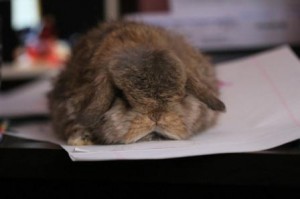Ever wonder why we call them ear numbers, when most of them have letters? I have no idea why. But today, we’ll be thinking about ear tattoos.
In order to show a rabbit in a rabbit show, the rabbit must be permanently tattooed in the left ear. If you are facing the rabbit, that’s the ear you can most easily grasp with your right hand.
If you purchase a rabbit that is already tattooed, your only responsibilities are to 1) never, ever change the ear number; it is the right of the breeder to select the ear numbers, and 2) to keep the tattoo touched up so that judges can readily read them.
If a tattoo fades, you should refer to the pedigree to determine what it should read before you touch it up (or have it touched up). If an error does occur and the tattoo is accidentally changed (or has to be changed due to a tattooing problem), you should notify the original breeder immediately and explain the problem. The breeder will probably understand if you let them know as opposed to just finding out about the change without the reason. He or she will want to change their records as well.
Now I should mention at this point that I had been practically banned from showing in Georgia until I got some of my tattoos touched up (I have). So I personally know what a struggle that can be to keep tattoos looking nice. I sympathize, but we all have to keep an eye on them.
If you purchase a rabbit that has not been tattooed, you should have it tattooed with the number indicated on the rabbit’s pedigree. Occasionally the breeder has no preference and will allow you to select the ear number. That’s the only time you would do so.
What about the rabbits that are born in your barn?
There are many systems for selecting ear numbers. Here are a few:
You can select short names and tattoo the entire name in the ear. Three and four letter names work best, like DAVE, SAL, and SUE.
You can select longer names and then choose a few letters to represent that name. Celtus’ ear number was “CEL,” for example. Fizzy Pop’s tattoo is FP.
You can select a system that identifies the parents or dam or sire. Valerie Harrell used a system of initials of the dam plus a number. She always liked watching my head jerk up when Natasha’s babies were shown because they were NT#. NT was for Natasha, so her first ten babies were NT1, NT2, NT3, NT4, NT5, NT6, NT7, NT8, NT9, and NTX. I liked the “x” because it saves a digit. Of course, once a doe has produced eleven babies, you are into double digit numbers anyway.
Valerie said that she could generally remember the sire if she had the dam’s initials as part of the tattoo. Other folks may be able to remember the dam and need initials to identify the sire.
Trying to put both a code for the dam and the sire and a unique identifier for the kit might make a lengthy number, but you could use two letters for the dam, two for the sire, and a letter for the kit, which would last through 26 kits for that particular match. That should be enough and it saves a digit over using numbers for the kit identifier. The challenge might be when you try to think up codes for May, Madge, MacKensie, Molly, Milly, Madam, and so forth, that make the code useful and worthwhile. You would need to keep a list to know that MA is May and ME is Madge.
A very popular system is to use a letter or letters to identify your rabbitry, plus the next number in line. That’s the system I use. I have NT### in my rabbits’ ears. My next number to assign is NT340. If I estimate how many kits I have in the barn right now, I can easily figure that I’ve produced approximately 375 rabbits since I started breeding. (When I reach 999, I will start with ###NT, then I can use N###T, if I still have NT rabbits living by then).
I’ve had some people complain that my number is too long. It’s hard to say whether I would just select N### if I had it all to do over or not. With a single number, it is easier for other people to select the same letter, making your rabbits less easy to identify.
Of course there are benefits and downsides to having your rabbits easy to identify. If I get distracted and don’t get my rabbit off the table in a timely manner (I really try to, but things do come up), then other breeders have been kind enough to bring me my rabbit.
But they’ve also been kind enough to bring me other people’s rabbits. When I sell rabbits, I do not mind if they are shown against me. So there may be two or three people showing “NT” rabbits at one time.
There’s no right or wrong way to select a system for identifying your rabbits. If you are just getting started, you may want to give it some thought so that you don’t have to change later on (and wish you had started with a different system).
Happy tattooing!

